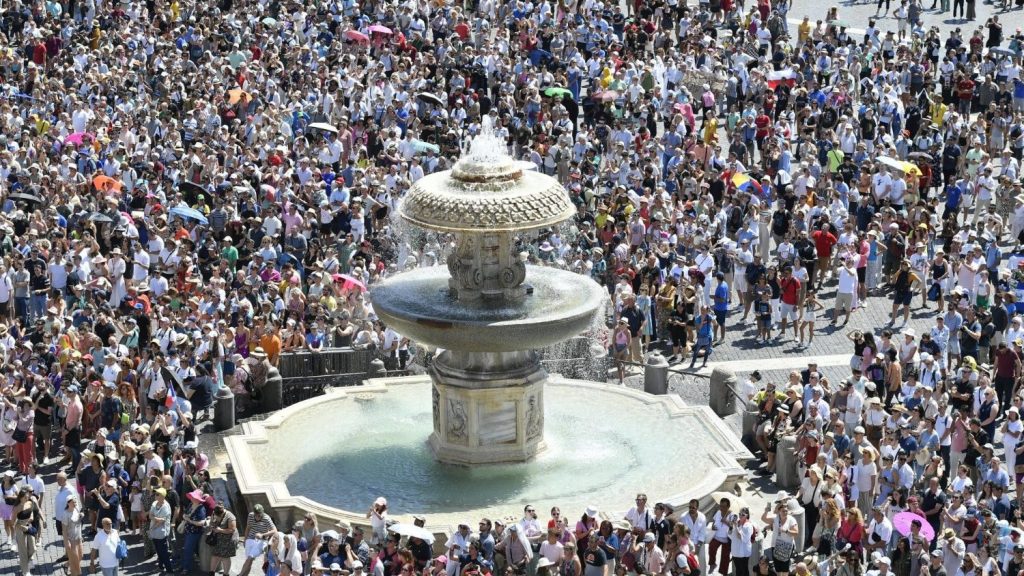(ZENIT News / Vatican City, 13.08.2023).- Some 15,000 people accompanied Pope Francis in Saint Peter’s Square on Sunday, August 13, to pray the Angelus. After his address and the Marian prayer, the Holy Father mentioned the shipwreck in the Mediterranean in which migrants died. He also mentioned the celebration that will take place in Cameroon on the feast of the Assumption of the Blessed Virgin Mary, and the continued suffering of the Ukrainian people enduring the war. Finally, Pope Francis expressed his closeness to the victims of the fires that are devastating parts of Hawaii
Here is the Pontiff’s catechesis, translated from the Italian original by the Holy See.
* * *
Today’s Gospel narrates a particular prodigious deed of Jesus: He walks at night on the waters of the Lake of Galilee toward His disciples who are crossing the Lake in a boat (cf. Matthew 14:22-33). The question is: Why did Jesus do this? Like a show? No! But why? Maybe because of an urgent, unforeseeable need to help His disciples who were blocked by a headwind? No, because He Himself had planned everything, He had made them depart that evening. The text even says He “made them” (cf. v. 22). Maybe He did it to give them a demonstration of his greatness and power? But it is not that simple with Him. So, why did He do it? Why did he want to walk on the water?
There is a message that is not evident, a message we need to grasp. In fact, at that time, great expanses of water were held to be the haunts of evil powers that man was not able to master. Particularly when storms made them turbulent, these abysses were symbols of chaos and recalled the darkness of the underworld. Now, the disciples found themselves in the middle of the Lake when it was dark. They are afraid of sinking, of being sucked in by evil. And Jesus comes here, walking on the water, that is, over the powers of evil. He walks on top of the powers of evil and says to His disciples: “Take heart; it is I. Do not be afraid” (v. 27). This is the message Jesus gives us. This is the meaning of the sign: the powers of evil that frighten us, that we cannot master, take on smaller proportions immediately with Jesus. By walking on the water, He wants to say, “Do not be afraid. I put your enemies under my feet” — a beautiful message — I put your enemies under my feet — not people! — not that type of enemy, but death, sin, the devil — these are the enemies of the people, our enemies. And Jesus tramples on these enemies for us.
Today, Christ repeats to each of us, “Take heart; it is I. Do not be afraid!” Take heart because I am here, because you are no longer alone on the turbulent waters of life. And so, what should we do when we find ourselves on the open sea at the mercy of headwinds? What should we do when we face the fear of the open sea, when we see only darkness and we feel we are going under? We need to do two things that the disciples do in the Gospel. What do the disciples do? They call on and welcome Jesus. At the worst moments, in the darkest of storms, call on Jesus and welcome Jesus.

The disciples call on Jesus: Peter walks a little on the water toward Jesus, but then gets frightened. He sinks and then cries out: “Lord, save me!” (v. 30). Invoke Jesus, call on Jesus. This prayer is beautiful. It expresses the certainty that the Lord can save us, that He conquers our evil and our fears. I invite you to repeat it now all together. Three times together: Lord, save me! Lord, save me! Lord, save me!
And then the disciples welcome, first they call on, then they welcome Jesus into the boat. The text says that as soon as He got into the boat, “the wind ceased” (v. 32). The Lord knows that the boat of our life, as well as the boat of the Church, is threatened by headwinds, and that the sea on which we sail is often turbulent. He does not spare us the hard work of sailing, rather — the Gospel emphasizes — He pushes His disciples to depart. He invites us to face difficulties so they too might become salvific places, so Jesus can conquer them, so they become opportunities to meet Him. In fact, in our moments of darkness, He comes to meet us, asking to be welcomed like that night on the lake.
So, let us ask ourselves: How do I react when I am afraid, in difficulties? Do I go ahead alone, with my own strength, or do I call on the Lord with trust? And what is my faith like? Do I believe that Christ is stronger than the adversarial waves and winds? But above all: Am I sailing with Him? Do I welcome Him? Do I make room for Him in the boat of my life — never alone, always with Jesus? Do I hand the helm over to Jesus?
In the dark crossings, may Mary, the Mother of Jesus, Star of the Sea, help us to seek the light of Jesus.



